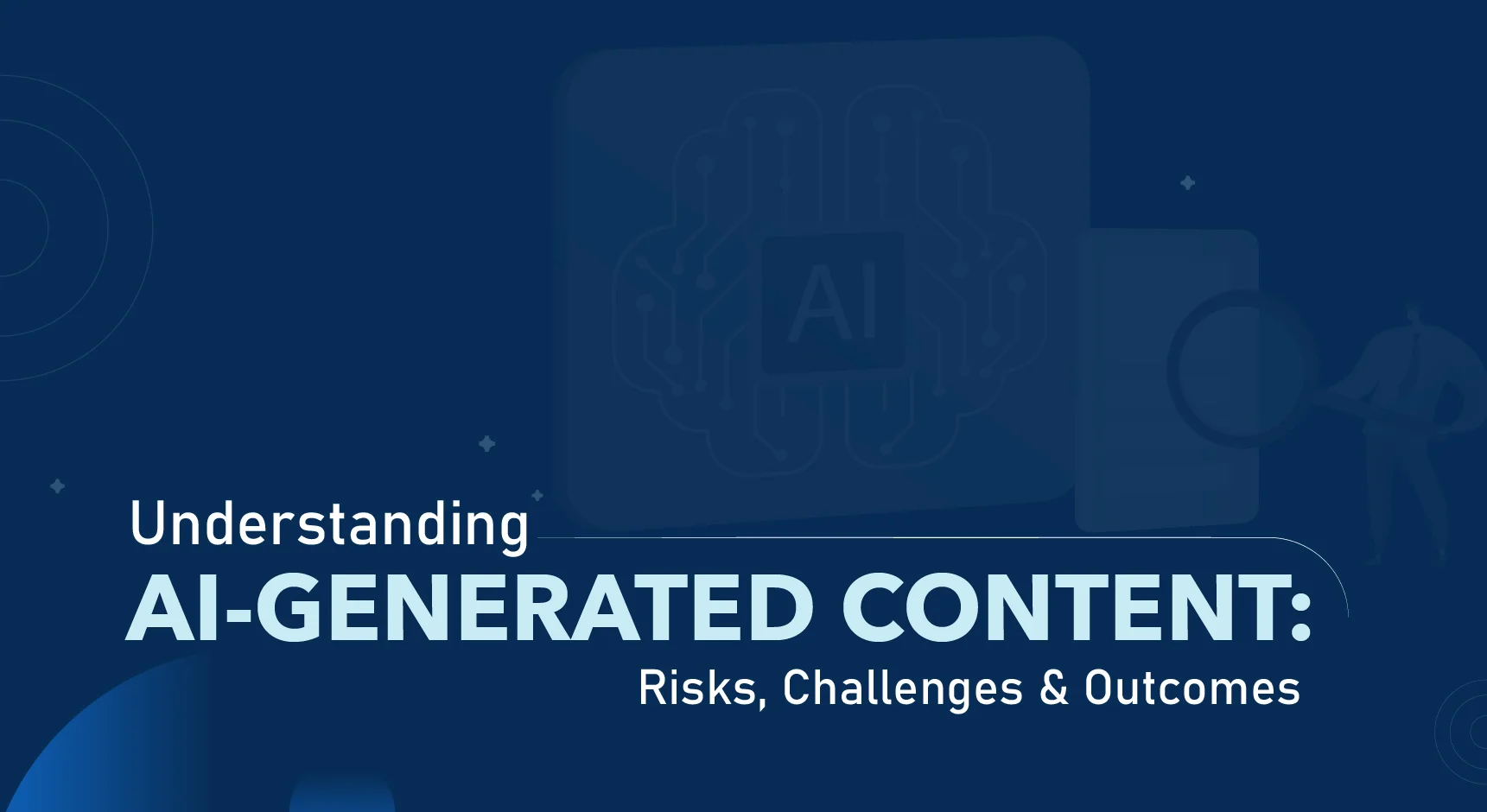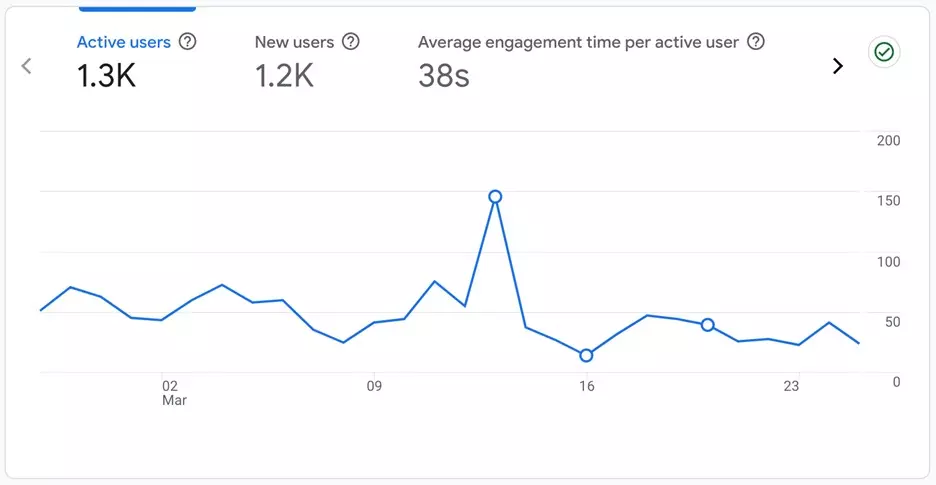


One of the biggest proponents of change in the marketing landscape has been the introduction of general-purpose AI,
more specifically for content creation. For marketers, it has completely changed how we create and optimize content.
Let's take a look at AI-generated content and how it has both positives and negatives to it.
Simply put, using any form of AI (tools, platforms) to generate content is classified as AI-generated Content.
Several platforms, like ChatGPT and DeepSeek, offer the latest AI model to the consumer. It is important to understand the difference between
AI platforms and models.
GPT and DeepSeek-V3 are AI models, while ChatGPT and DeepSeek are 'tools' that use these models to generate output.

That said, are there risks to generating content without any human intervention? You bet there are! Here are a few of them.
The most obvious and glaring risk of AI content is its 'sameness' or generic nature by default. This is the result of Large Language Models (LLMs) aggregating text all over the internet and producing results that align with a widely acceptable style of writing.
While the result will have minimal grammatical errors, it will have no 'personality' behind it and might also have factual errors depending on the topic.
Relying on AI to create content, both textual and visual, has the same flaws. It just outputs the average of what you asked for.
You can tweak the newer language models like GPT4 to some extent, but the result produced by it by and large will be mostly generic and uninspired. In some cases, this type of content generation can also trigger plagiarism checks which is a whole new level of poor-quality content.

While it is true that content is created to engage and inform, the other side of the coin is that businesses are also looking at it in terms of SEO performance.
An aspect that we take for granted with human writers is their ability to weave the intricacies of SEO into an article. Most times these LLMs produce thin content that is generic and doesn't directly address the subject.
Content like this has very little SEO strength because you cannot incorporate the right keywords without related topics. Let's take the example of a kayaking article.
Until you write in depth about it, you cannot include keywords related to it like kayaking techniques or kayaking gear. Another area where AI is still developing is semantic relevance. Based on its training, it can put out content that might not be related to the topic at all.
The primary reason for businesses not opting for AI content is search engine penalties. It is no secret that search engines, especially Google, hate spammy low-quality content.
Now with cheap AI models, it has exacerbated this problem leading to huge walls of text with little value for the users. As a result of this, search engines have been found to penalize content that is AI-generated.
These penalties range from deindexing their websites to loss of domain authority over time, to even manual action. Google has also reinforced its spam rule for content which classifies low-quality AI content as spam.
Getting back to where they're from can be expensive and time-consuming. This is one important reason why content creators are forced to curb AI use to generate content. Or at the very least, have adequate human input so it won't read or look generic.
For brands chasing success in a competitive market, it is vital to be authentic to their brand voice and user expectations.
Choosing AI content can result in a 'stiff' and 'unnatural' tone of content which can be an instant turn-off for both users and search engines.
The robotic and predictable nature of AI content is completely misaligned with your original brand's voice. It can lead to confusion about the highest order for your customers.
Furthermore, because AI content is generic, it fails to hold user interest. It can lead to them clicking away from your page or worse, opting for your competitors' services.
Using AI for branded content can have serious repercussions including having to redo the entire content from scratch. Opting for AI-generated content for branded content is not a great idea even for the short term.
With hundreds of thousands of businesses competing for the same slice of the pie, user engagement becomes supremely important.
Engagement numbers are one of the most important criteria on which search results are decided. But the bad news is a majority of AI-generated content can be uninspiring, which can be a huge putoff for people visiting your website.

Uninterested customers will not share or comment on your content, these are key aspects of engagement metrics.
From a technical SEO perspective, people clicking away results in higher bounce rates, a red flag for search engines that can drop your website link even lower on searches.
Reduced interactions mean lower conversion rates and a hugely negative impact on your brand reputation.
An aspect that most people are not talking about and get very little press on is the ethical and legal problems associated with AI-generated content.
Many people think that an AI model 'creates' content out of thin air - this is far from the truth. AI models simply act as information aggregators, meaning they collect information from all over the web. Naturally, during this process, copyrighted content from creators is also hoovered up.
This can create copyright infringements and violation of privacy, risking serious legal penalties for businesses relying on AI for content.
There are many examples of generative AI content sued for copyright infringement. These are serious real-world implications of using AI and need to be taken into consideration before it gets worse.
Leveraging generative AI can be useful when it comes to cutting down production times. AI content creation pipelines are sometimes 90% faster when it comes to turnaround times.
While a human writer could take hours to research and write on a specific topic, the latest AI models could do that in minutes. Even if it does take time to edit and make it ready, the AI still beats the human, hands down!
Another area is the cost-effectiveness of AI. Every business looks at profit margins, and this is an area where AI can deliver the numbers in spades.
While monthly costs for AI seem expensive, it's still cheaper than a team of writers and will outperform them. Another aspect that needs to be mentioned is that AI has 24/7 uptime, which in itself is a 300% increase in productivity over a human.
It can be next to impossible for businesses looking to scale up writers quickly. The reasons are simple, it takes time to train people and most of them have a limited area of expertise.
Both of these concerns are immaterial when you loop in an AI content generation. Most generative AIs can create content on a huge variety of topics and types of content. Text, images, and videos are part of the package!
An AI doesn't need any training when you need to shift from one topic to another, it simply delivers. This makes it suitable for a wide range of tasks and scalable across various business verticals without any or minimal overhead.
A hard-to-ignore bonus factor of AI content is its ability to adapt to various languages and dialects. And the best part about all this is that AI is consistent and reliable, you'll never miss a deadline again.
Keeping content fresh and engaging is a challenging and time-consuming task. Top brands spend more time on research than actually creating content.
The reason is that a single topic has been covered hundreds of times all over the world. But generative AI can make a tangible difference here. With AI, you can get different content angles that have less coverage and better scope for engagement.
You can get AI to suggest new topics and related content ideas for a much more engaging content campaign. It can help with brainstorming ideas for your topics and also suggest the best content platforms that you can leverage to market it.
Content teams can also use AI to analyze gaps in their content strategy and deal with them.
Target demographics play an essential part in website design, and the type of users who frequent your website decide what your website will look like. A good example of this is a niche like health care or hospitals. If you've noticed, some standard colors and layouts are used for these kinds of websites.
The choice is not just based on standards but also on the people who visit these websites. They want to get the right information quickly without any confusion.
Contrast this to a popular sportswear brand's website. You'll find a lot of detailed graphics, animation, and splashy text with varying layouts. It helps to create a user avatar with all their preferences to ensure you get the right design for your audience.
What type of designs do they prefer? What kind of information are they looking for?
How easy is navigating their website? All these are essential questions to answer.
On the positive side of things, one of the more favorable outcomes of using AI generative tools is a more efficient content creation pipeline.
Small and medium-sized businesses around the world are being held back on the marketing front because of content creation. Since they don't have the financial power or time, content creation is a huge hurdle for them.
They're just not able to focus on creating high-quality content consistently over time.
Opting for AI gives them several advantages that level the playing field between them and much bigger competitors. With generative AI, they can mass produce content like blogs and social media posts which can help them gain a lot of engagement.
Using AI means quicker publishing times and no more missing deadlines. More advanced AI content generation models can also handle omnichannel marketing, which can help with different content types like images and video.
Content generation for marketing has become more expensive over time. It is estimated that marketing spending will reach 1.87 trillion dollars this year - that is a whole chunk of change!
The problem here is that this pushes smaller companies away from the market widening the gap even further between the top competitors and the newer ones. AI has the potential to cut spending significantly and help these smaller companies compete in the market.
With a generative AI content pipeline, brands can cut down on content agencies and opt for AI-assisted content freelancers. Content generation reduces the need to proofread or edit the document for errors, further improving turnaround times.
Rather than force your team members to create content, they can focus on what they're good at. Lastly, it improves the content you get per dollar which means better ROI for your marketing.
With the positives, there are also significant negatives that are associated with AI content.
The most talked about is the generic quality of AI-generated content. Even the biggest supporters of AI agree that content can appear 'same and uninspired'. It lacks any sort of depth and originality that are normally present when a human writes a piece.
Many readers completely skip AI-generated articles or videos because it just seems so impersonal to them. Even leaving aside the aesthetic value of the content, factual errors, and even outright exaggerations are a common facet of AI articles.
Compared to a well-researched article, an AI article falls considerably short when holding the attention of a customer.
Since the AI content generation pipeline is reasonably predictable, search engines have found ways to identify AI-generated content. These AI articles are at the risk of being penalized for poor quality and spam much more than human-written ones.

A generative AI article has poor Expertise, Authority, and Trust (EAT) metrics, which are the cornerstones of Google's search engine algorithm.
Low-quality AI-generated content, also known as AI slop, has a huge negative impact on the website. It reduces the chances of being ranked on the first page and sometimes even deindexes the link for related searches.
● Balance AI efficiency with human authenticity and creativity to achieve the right results.
● Evaluate and audit AI-generated content regularly and make changes as necessary.
● Edit AI content and align it to your brand voice before posting to ensure that it isn't flagged by search engines.
● Experiment and A/B test various topics with different AI models to find one that works for you.
● Refine AI drafts with the help of professional editing tools and writers to get the best content pipeline.